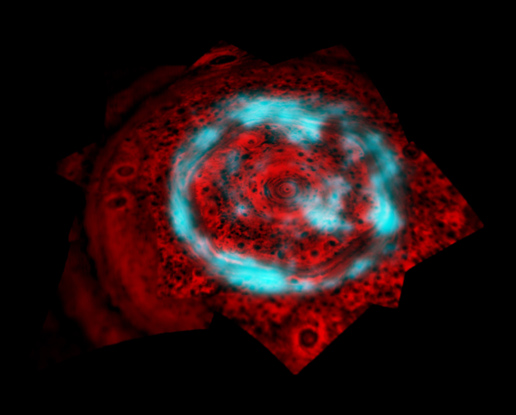"We've never seen an aurora like this elsewhere," said Tom Stallard, an RCUK Academic Fellow working with Cassini data at the University of Leicester. Stallard is lead author of a paper released today in the British journal Nature. "It's not just a ring of aurorae like those we've seen at Jupiter or Earth. This one covers an enormous area across the pole. Our current ideas on what forms Saturn's aurorae predict that this region should be empty, so finding such a bright one here is a fantastic surprise."
Aurorae are caused when charged particles stream along the magnetic field of a planet and into its atmosphere. On Earth these charged particles come from the solar wind a stream of particles that emanaates from the Sun.

This image of the northern polar region of Saturn shows both the aurora and underlying atmosphere, seen at two different wavelengths of infrared light as captured by NASA’s Cassini spacecraft. Energetic particles, crashing into the upper atmosphere cause the aurora, shown in blue, to glow brightly at 4 microns (six times the wavelength visible to the human eye). The image shows both a bright ring, as seen from Earth, as well as an example of bright auroral emission within the polar cap that had been undetected until the advent of Cassini. This aurora, which defies past predictions of what was expected, has been observed to grow even brighter than is shown here. Silhouetted by the glow (cast here to the color red) of the hot interior of Saturn (clearly seen at a wavelength of 5 microns, or seven times the wavelength visible to the human eye) are the clouds and haze that underlie this auroral region. For a similar view of the region beneath the aurora see http://photojournal.jpl.nasa.gov/catalog/PIA09185 . This image is a composite captured with Cassini’s visual and infrared mapping spectrometer. The aurora image was taken in the near-infrared on Nov. 10, 2006, from a distance of 1,061,000 kilometers (659,000 miles), with a phase angle of 157 degrees and a sub-spacecraft planetocentric latitude of 52 degrees north. The image of the clouds was obtained by Cassini on June 15, 2008, from a distance of 602,000 kilometers (374,000 miles) and a sub-spacecraft planetocentric latitude of 73 degrees north. The Cassini-Huygens mission is a cooperative project of NASA, the European Space Agency and the Italian Space Agency. The Jet Propulsion Laboratory, a division of the California Institute of Technology in Pasadena, manages the mission for NASA's Science Mission Directorate, Washington, D.C. The Cassini orbiter was designed, developed and assembled at JPL. The Visual and Infrared Mapping Spectrometer team is based at the University of Arizona. For more information about the Cassini-Huygens mission visit http://saturn.jpl.nasa.gov . The Cassini imaging team homepage is at http://ciclops.org . Credit:NASA/JPL/University of Arizona
Jupiter's main auroral ring, caused by interactions internal to Jupiter's magnetic environment, is constant in size. Saturn's main aurora, which is caused by the solar wind, changes size dramatically as the wind varies. The newly observed aurora at Saturn, however, doesn't fit into either category.
"Saturn's unique auroral features are telling us there is something special and unforeseen about this planet's magnetosphere and the way it interacts with the solar wind and the planet's atmosphere," said Nick Achilleos, Cassini scientist on the Cassini magnetometer team at the University College London. "Trying to explain its origin will no doubt lead us to physics which uniquely operates in the environment of Saturn."
The new infrared aurora appears in a region hidden from NASA's Hubble Space Telescope, which has provided views of Saturn's ultraviolet aurora. Cassini observed it when the spacecraft flew near Saturn's polar region. In infrared light, the aurora sometimes fills the region from around 82 degrees north all the way over the pole. This new aurora is also constantly changing, even disappearing within a 45 minute-period.
The Cassini-Huygens mission is a cooperative project of NASA, the European Space Agency and the Italian Space Agency. The UK researchers have been funded by the Science and Technology Facilities Council (STFC) and Research Councils UK (RCUK). The Jet Propulsion Laboratory, a division of the California Institute of Technology in Pasadena, manages the mission for NASA's Science Mission Directorate, Washington, D.C. The Cassini orbiter was designed, developed and assembled at JPL. The visual and infrared mapping spectrometer team is based at the University of Arizona, Tucson.
The research is drawn from data collected by NASA's InfraRed Telescope Facility. Saturn's main aurora has been studied using the NASA/ESA Hubble Space Telescope.
Article: "Complex structure within Saturn's infrared aurora", Tom Stallard1, Steve Miller2, Makenzie Lystrup2, Nicholas Achilleos2, Emma J. Bunce1, Christopher S. Arridge3, Michele K. Dougherty4, Stan W. H. Cowley1, Sarah V. Badman1, Dean L. Talboys1, Robert H. Brown5, Kevin H. Baines6, Bonnie J. Buratti6, Roger N. Clark7, Christophe Sotin6, Phil D. Nicholson8&Pierre Drossart9
1 Department of Physics and Astronomy, University of Leicester, Leicester LE1 7RH, UK.
2 Atmospheric Physics Laboratory, Department of Physics and Astronomy, University College London, Gower Street, London WC1E 6BT, UK.
3 Department of Space and Climate Physics, Mullard Space Science Laboratory, University College London, Holmbury St Mary, Dorking, Surrey RH5 6NT, UK.
4 Space and Atmospheric Physics Group, Department of Physics, Imperial College of Science, Technology and Medicine, South Kensington Campus, London SW7 2AZ, UK.
5 Lunar and Planetary Laboratory and Steward Observatory, University of Arizona, Tucson, Arizona 85721-0092, USA.
6 Jet Propulsion Laboratory, California Institute of Technology, M/S 183-601, 4800 Oak Grove Drive, Pasadena, California 91109-8099, USA.
7 US Geological Survey, Denver, Colorado 80225, USA.
8 Cornell University, Astronomy Department, Ithaca, New York 14853, USA.
9 Observatoire de Paris, Meudon 92195, France.





Comments